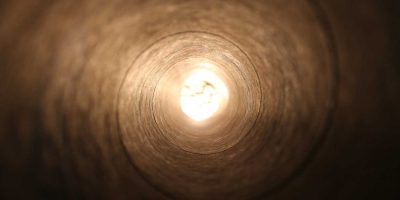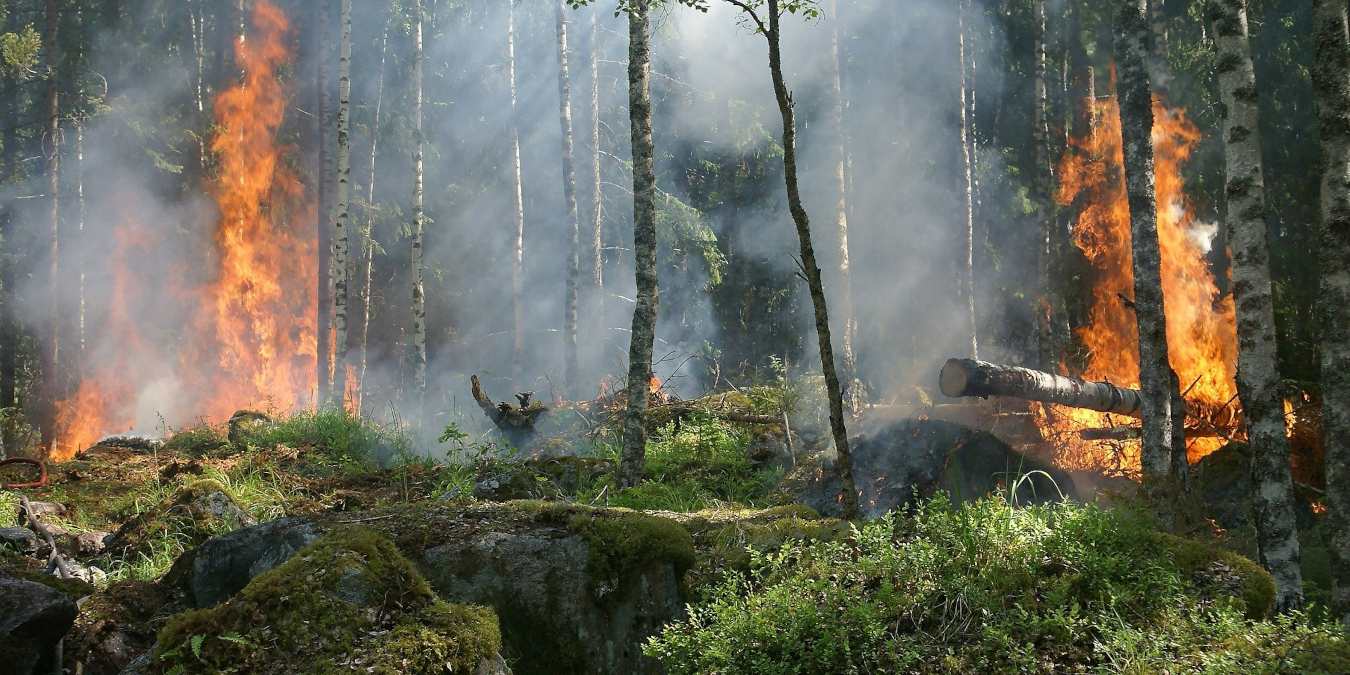
As the Northern Hemisphere prepares for another summer, fire authorities will be making plans. As summers grow hotter, the risks of fires increase. Fires destroy ecosystems, damage the environment, flatten businesses and homes and cause the loss of wildlife and the death of animals and people. Fortunately, one startup, German company Dryad, has found a way to respond to the unique challenges of fire detection in remote areas, creating an “Internet of the forest” solution. I spoke to CEO and co-founder Carsten Brinkschulte to find out more.
The value of deep domain telco knowledge
Part of the strength of Dryad is Carsten’s entrepreneurial background and experience in telecommunications, where he’s previously exited three startups, including Core Networks Dynamics, which were acquired by Twilio in 2018. He shared that after an exit, “you kind of fall into a hole if you don’t know what to do next.”
Carsten was sitting with a hardware developer friend of 40 years discussing the fires burning in the Amazon forests in Brazil in 2018. They decided to consolidate the knowledge they’d built over the years and use technology to fight wildfires.
The challenge of detecting forest fires
Detecting forest fires is difficult, as forests are typically remote in inaccessible areas, making it hard to respond to fires and natural disasters. Dryad aims to not only detect fires but prevent them through the ultra-early detection of forest fires, within their first hour, or even the first 30 minutes. As Carsten notes:
“We need to alert the fire brigades very early on. The fire has to be small enough to extinguish by the time they get to the scene. There’s no use alerting them to a fire the size of a football pitch because you can’t extinguish that anymore.”
Other providers have focused on the use of satellites or cameras in trees to detect smoke. However, the problem is they take too long to detect fires.
Carsten explained: “These optical systems take one to three hours before they can detect the smoke plume. Early intervention is also critical to create safe evacuation plans during wildfires. Fires move fast, especially on windy days, and can easily spread, overpowering people fleeing fires by car and damaging the neighboring towns. Further, hardware materials for the Internet of the forest need to be cheap, scalable, easily deployed, ruggedized, and designed to run for at least 20 years without maintenance. These need to be deployed in steep and inaccessible places to have the most impact.”
An Internet of the forest
In response to the challenges of the forest, Dryad has created an application (and hardware solution) that’s the first of its kind, a communication network for areas where there isn’t any network, effectively a Vodaphone of the forest. But its purpose is far more mission-critical than simply communication – it’s about detecting fires and alerting authorities to prevent their spread.
However, as Carsten explains, “You typically don’t have any mobile communications in remote forests. So since I’m a network guy, we built our own mobile network and our own base stations that would enable sensors to communicate in areas where there isn’t any communication network.”
Dryad has developed gas sensors that are attached to small leaf-style devices airdropped by drone or airplane to stick in the tree branches. Carsten explained:
“We’re looking for the gas patterns that emerge when you heat up organic material. Currently, we’re running machine-,learning AI software on indoor sensors that look for the gas patterns that are typical for a wildfire. When they see that we teach the AI the typical gas patterns for a eucalyptus tree forest or redwood forests, wherever we’re going to deploy them, then they will be trained ,and they will be able to detect a fire very early on.”
The sensors will also measure temperature and humidity because typically, wildfires happen when it’s dry and hot. But the critical element is the trigger of carbon monoxide, carbon dioxide, hydrogen, and other gases that are emitted in the early stages of wildfire, which is called the smoldering stage. Ultimately, the aim is to detect the fire before the open flames start.
How to power the Internet of the forest?
Dryad’s IoT solution is powered by a mesh network of LoRa gateways. LoRa is used because it provides long-range plow power communications. But as Carsten explains, LoRa has a star network architecture. Therefore, you have one gateway that can connect to multiple sensors. But the gateway has to have an Internet connection. This is a problem in the middle of a forest the size of many cities – the middle of nowhere where you don’t have any direct network connection.
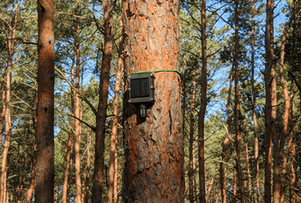
In response, Dryad has developed mesh gateways, where the gateways talk to each other until they reach a border gateway, which is a gateway that actually does have an Internet connection. With these mesh gateways, Dryad is able to extend the network coverage deep into the forest with 10, 15, 20 hops right within the forest, where each gateway can have a few hundred sensors hanging off it. Carston explains:
“You’re basically building a mesh of stars. These are connected to a border gateway that does the relay into the net. This gateway then brings the data to our cloud analytics platform where we store the data, make sense of the data, and can send out alerts in email or SMS form and alert people if something has happened.”
The solution is a great use case for edge computing. As Carsten shared, “We do not have the luxury to do cloud computing in the first instance because the bandwidth of the LoRaWAN network and latency of the mesh doesn’t allow central data processing. So in fact, all of our data processing is done on the edge in the sensors themselves. We’re not sending any video or audio streams or having big streams of data coming from the gas sensor in real time. So we have to do this at the very edge.“
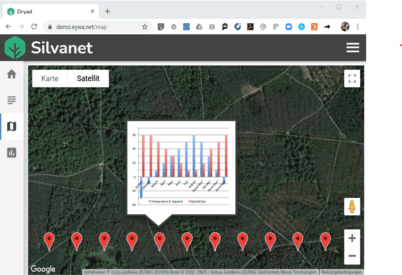
Last year Dryad created their first prototype, a solar-powered gas sensor that could be attached to a tree, work off-grid, and would detect a fire and send out an alert. Since then they’ve created a cloud network, raised 1.8 million Euros in funding, including strategic investments, such as a chainsaw manufacturer and an energy company that is the largest owner of forests in Germany. They’re scaling their team and turning their prototype into a real prototype with plans to go live with these proof of concepts in the summer prior to mass production.
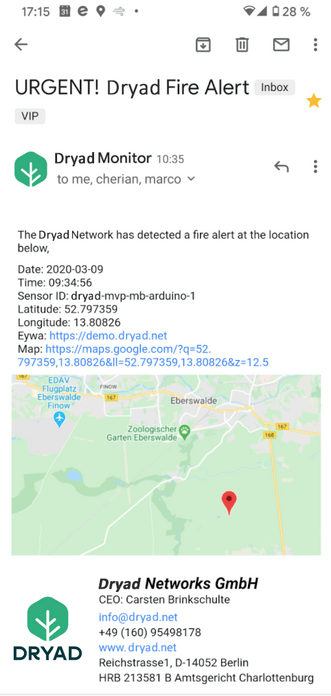
The business value of the IoT of the forest
Previous IoT forest fire detection models have struggled to gain traction in a business sense. By comparison, Dryad sees three customers for their solution:
- Private forest owners who want to protect their assets, their crops.
- The government ownership of public land, where the authorities have a duty to protect both the environmental ecosystem as well as the people living in it or near it.
- Utility companies, which are often causing the wildfires. In the US, PG&E was charged over the 2019 wildfires in California.
The company plans to go to market is with OEM agreements licensing their technology to companies with a large global presence. Deploying sensors and networks in forests requires a lot of effort in deploying and maintaining the infrastructure. “For that, you need lots of people in local organizations, which we don’t have. So we’re focusing on the actual product. And we’ll let others do the deployment and the business and share the revenue with them.”





